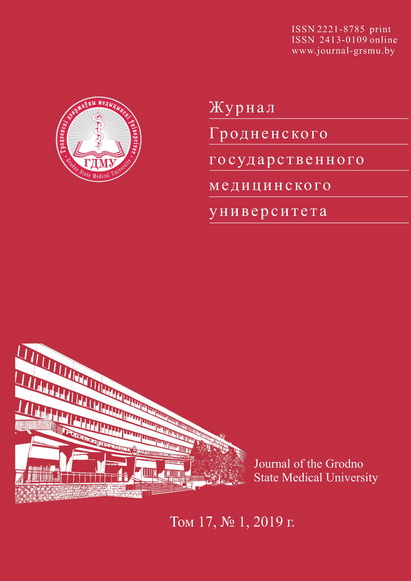КОНЕЧНЫЕ ПРОДУКТЫ ГЛИКИРОВАНИЯ И ИХ РЕЦЕПТОРЫ ПРИ СЕРДЕЧНО-СОСУДИСТЫХ ЗАБОЛЕВАНИЯХ
Аннотация
Конечные продукты гликирования (КПГ) – гетерогенная группа веществ, образующихся при взаимодействии сахаров и активных карбонильных соединений с белками и липидами. Цель данного обзора – обсуждение роли КПГ и их рецепторов (RAGE) в патогенезе и диагностике сердечно-сосудистых заболеваний, не связанных с диабетом. Рассмотрены новые подходы к лечению сердечной недостаточности на основе регуляции содержания КПГ и RAGE
Литература
Lingelbach LB, Mitchell AE, Rucker RB, Mc Donald RB. Accumulation of advanced glycation end-products in aging male Fischer 344 rats during long-term feeding of various dietary carbohydrates. J. Nutr. 2000;130(5):1247-1255. doi: 10.1093/jn/130.5.1247.
Petrica L, Vlad A, Gluhovschi G, Gadalean F, Dumitrascu V, Vlad D, Popescu R, Velciov S, Gluhovschi C, Bob F, Ursoniu S, Petrica M, Jianu DC. Glycated peptides are associated with the variability of endothelial dysfunction in the cerebral vessels and the kidney in type 2 diabetes mellitus patients: a cross-sectional study. J. Diabetes Complications. 2015;29(2):230-237. doi: 10.1016/j.jdiacomp.2014.11.014.
Deluyker D, Evens L, Bito V. Advanced glycation end products (AGEs) and cardiovascular dysfunction: focus on high molecular weight AGEs. Amino Acids. 2017;49(9):1535-1541. doi: 10.1007/s00726-017-2464-8.
Li J, Liu D, Sun L, Lu Y, Zhang Z. Advanced glycation end-products and neurodegenerative diseases: mechanisms and perspective. J. Neurol. Sci. 2012;317(1-2):1-5. doi: 10.1016/j.jns.2012.02.018.
Lozinska LМ, Semchyshyn HМ. Bіologіchnі aspekti neenzimatichnogo glіkoziljuvannja [Biological aspects of non-enzymatic glycosylation]. Ukrainskij biohimicheskij zhurnal [The Ukrainian Biochemical Journal]. 2012;84(5):16-37. (Ukrainian).
Lorenzi M. The polyol pathway as a mechanism for diabetic retinopathy: attractive, elusive, and resilient. Exp. Diabetes Res. 2007;2007(16):1-10. doi: 10.1155/2007/61038.
Vistoli G, De Maddis D, Cipak A, Zarkovic N, Carini M, Aldini G. Advanced glycoxidation and lipoxidation end products (AGEs and ALEs): an overview of their mechanisms of formation. Free Radic Res. 2013;47(1):3-27. doi: 10.3109/10715762.2013.815348.
Rabbani N, Thornalley PJ. Dicarbonyl stress in cell and tissue dysfunction contributing to ageing and disease. Biochem. Biophys. Res. Commun. 2015;458(2):221-226. doi: 10.1016/j.bbrc.2015.01.140.
Schmidt AM, Yan SD, Yan SF, Stern DM. The biology of the receptor for advanced glycation end-products and its ligands. Biochim. Biophys. Acta. 2000;1498(2-3):99-111.
Pricci F, Leto G, Amadio L, Iacobini C, Romeo G, Cordone S, Gradini R, Barsotti P, Liu FT, Di Mario U, Pugliese G. Role of galectin-3 as a receptor for advanced glycosylation end - products. Kidney Int. Suppl. 2000;77:31-39.
Menini S, Iacobini C, Ricci C, Blasetti Fantauzzi C, Salvi L, Pesce CM, Relucenti M, Familiari G, Taurino M, Pugliese G. The galectin-3/RAGE dyad modulates vascular osteogenesis in atherosclerosis. Cardiovasc. Res. 2013;100:472-480. doi: 10.1093/cvr/cvt206.
Ott C, Jacobs K, Haucke E, Navarrete Santos A, Grune T, Simm A. Role of advanced glycation end-products in cellular signaling. Redox. Biol. 2014;2:411-429. doi: 10.1016/j.redox.2013.12.016.
Xue J, Manigrasso M, Scalabrin M, Rai V, Reverdatto S, Burz DS, Fabris D, Schmidt AM, Shekhtman A. Change in the Molecular Dimension of a RAGE-Ligand Complex Triggers RAGE Signaling. Structure. 2016;24(9):1509-1522. doi: 10.1016/j.str.2016.06.021.
Neviere R, Yu Y, Wang L, Tessier F, Boulanger E. Implication of advanced glycation end products (Ages) and their receptor (Rage) on myocardial contractile and mitochondrial functions. Glycoconj. J. 2016;33(4):607-617. doi: 10.1007/s10719-016-9679-x.
Rabbani N, Thornalley PJ. Dicarbonyl proteome and genome damagein metabolic and vascular disease. Biochem. Soc. Trans. 2014;42(2):425-432. doi: 10.1042/BST20140018.
Ahmad S, Akhter F, Shahab U, Khan MS. Studies on glycation of human low density lipoprotein: a functional insight into physico-chemical analysis. Int. J. Biol. Macromol. 2013;62:167-171. doi: 10.1016/j.ijbiomac.2013.08.037.
Aronson D. Cross-linking of glycated collagen in the pathogenesis of arterial and myocardial stiffening of aging and diabetes. J. Hypertens. 2003;21(1):3-12. doi: 10.1097/01.hjh.0000042892.24999.92.
Deluyker D, Ferferieva V, Noben JP, Swennen Q, Bronckaers A, Lambrichts I, Rigo JM, Bito V. Cross-linking versus RAGE: How do high molecular weight advanced glycation products induce cardiac dysfunction? Int. J. Cardiol. 2016;210:100-108. doi: 10.1016/j.ijcard.2016.02.095.
Khan MS, Tabrez S, Rabbani N, Shah A. Oxidative Stress Mediated Cytotoxicity of Glycated Albumin: Comparative Analysis of Glycation by Glucose Metabolites. J. Fluoresc. 2015;25(6):1721-1726. doi: 10.1007/s10895-015-1658-2.
Rabbani N, Godfrey L, Xue M, Shaheen F, Geoffrion M, Milne R, Thornalley PJ. Glycation of LDL by Methylglyoxal Increases Arterial Atherogenicity. Diabetes. 2011;60(7):1973-1980. doi: 10.2337/db11-0085.
Codfrey L, Yamada-Fowler N, Smith J, Thornalley PJ, Rabbani N. Arginine-directed glycation and decreased HDL plasma concentration and functionality. Nutr Diabetes. 2014;4:e134. doi: 10.1038/nutd.2014.31.
Hanssen NM, Wouters K, Huijberts MS, Gijbels MJ, Sluimer JC, Scheijen JL, Heeneman S, Biessen EA, Daemen MJ, Brownlec M, de Kleijn DP, Stehouwer CD, Pasterkamp G, Schalkwijk CG. Higher levels of advanced glycation end products in human carotid atherosclerotic plaques are associated with a rupture-pron phenotype. Eur. Heart J. 2014;35(17):1137-1146. doi: 10.1093/eurheartj/eht402.
Ramasamy R, Yan SF, Schmidt AM. Advanced glycation endproducts: from precursors to RAGE: round and round we go. Amino Acids. 2012;42(4):1151-1161. doi: 10.1007/s00726-010-0773-2.
Pugliese G, Iacobini C, Blasetti Fantauzzi C, Menini S. The dark and bright side of atherosclerotic calcification. Atherosclerosis. 2015;238(2):220-230. doi: 10.1016/j.atherosclerosis.2014.12.011.
Bolton WK, Cattran DC, Williams ME, Adler SG, Appel GB, Cartwright K, Foiles PG, Freedman BI, Raskin P, Ratner RE, Spinowitz BS, Whittier FC, Wuerth JP. Randomized trial of an inhibitor of formation of advanced glycation end products in diabetic nephropathy. Am. J. Nephrol. 2004;24(1):32-40. doi: 10.1159/000075627.
Freedman BI, Wuerth JP, Cartwright K, Bain RP, Mooradian AD, Spinowitz BS. Design and baseline characteristics for the aminoguanidine Clinical Trial in Overt Type 2 Diabetic Nephropathy (ACTION II). Control Clin. Trials. 1999;20(5):493-510.
Li X, Zheng T, Sang S, Lv L. Quercetin inhibits advanced glycation end product formation by trapping methylglyoxal and glyoxal. J. Agric. Food Chem. 2014;62(50):12152-12158. doi: 10.1021/jf504132x.
Liu G, Xia Q, Lu Y, Zheng T, Sang S, Lv L. Influence of Quercetin and Its Methylglyoxal Adducts on the Formation of α-Dicarbonyl Compounds in a Lysine/Glucose Model System. J. Agric. Food Chem. 2017;65(10):2233-2239. doi: 10.1021/acs.jafc.6b05811.
Silvan JM, Srey C, Ames JM, del Castillo MD. Glycation is regulated by isoflavones. Food Funct. 2014;5(9):2036-2042. doi: 10.1039/c4fo00260a.
Tkachenko V, Kovalchuk Y, Bondarenko N, Bondarenko О, Ushakova G, Shevtsova A. The cardio- and neuroprotective effects of Corvitin and 2-oxoglutarate in rats with pituitrin-isoproterenol-induced myocardial damage. Biochem. Res. Int. 2018;2018:1-11. doi: 10.1155/2018/9302414.
Hwang SH, Kim HY, Zuo G, Wang Z, Lee JY, Lim SS. Anti-glycation, Carbonyl Trapping and Anti-inflammatory Activities of Chrysin Derivatives. Molecules. 2018;23(7):е1752. doi: 10.3390/molecules23071752.
Prasad K. Tiwari S. Therapeutic Interventions for Advanced Glycation-End Products and its Receptor - Mediated Cardiovascular Disease. Curr. Pharm. Des. 2017;23(6):937-943. doi: 10.2174/1381612822666161006143032.
Paradela-Dobarro B, Raposeiras-Roubín S, Rodiño-Janeiro BK. Statins modulate feedback regulation mechanisms between advanced glycation end-products and C-reactive protein: evidence in patients with acute myocardial infarction. Eur. J. Pharm. Sci. 2013;49(4):512-518. doi: 10.1016/j.ejps.2013.05.001.
Lee S, Piao C, Kim G, Kim JY, Choi E, Lee M. Production and application of HMGB1 derived recombinant RAGE-antagonist peptide for anti-inflammatory therapy in acute lung injury. Eur. J. Pharm. Sci. 2018;114:275-284. doi: 10.1016/j.ejps.2017.12.019.
Rouhiainen A, Nykänen NP, Kuja-Panula J, Vanttola P, Huttunen HJ, Rauvala H. Inhibition of Homophilic Interactions and Ligand Binding of the Receptor for Advanced Glycation End Products by Heparin and Heparin-Related Carbohydrate Structures. Medicines. 2018;5(3):е79. doi: 10.3390/medicines5030079.






























